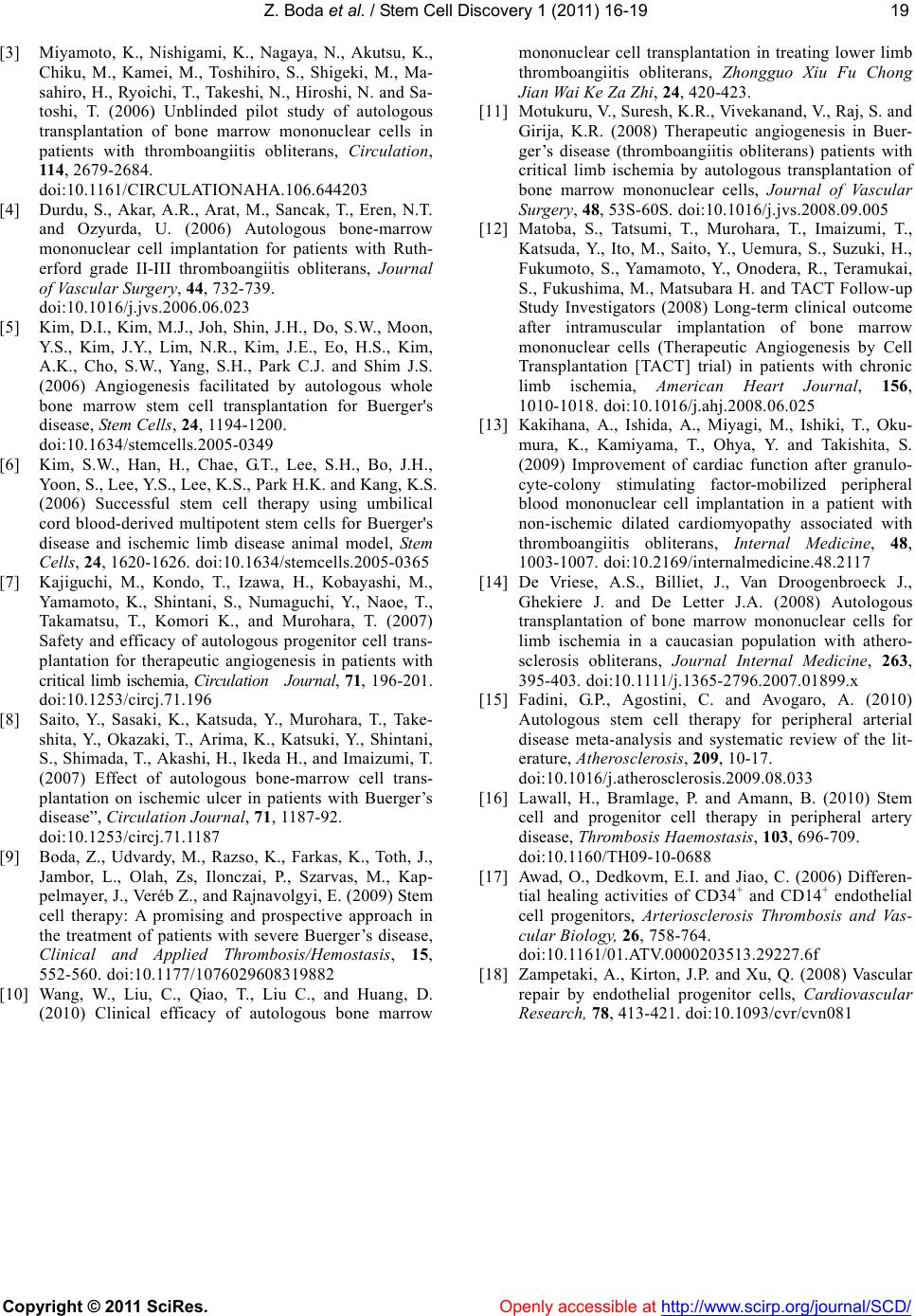
Z. Boda et al. / Stem Cell Discovery 1 (2011) 16-19
Copyright © 2011 SciRes. http://www.scirp.org/journal/SCD/ Openly accessible at
1919
[3] Miyamoto, K., Nishigami, K., Nagaya, N., Akutsu, K.,
Chiku, M., Kamei, M., Toshihiro, S., Shigeki, M., Ma-
sahiro, H., Ryoichi, T., Takeshi, N., Hiroshi, N. and Sa-
toshi, T. (2006) Unblinded pilot study of autologous
transplantation of bone marrow mononuclear cells in
patients with thromboangiitis obliterans, Circulation,
114, 2679-2684.
doi:10.1161/CIRCULATIONAHA.106.644203
[4] Durdu, S., Akar, A.R., Arat, M., Sancak, T., Eren, N.T.
and Ozyurda, U. (2006) Autologous bone-marrow
mononuclear cell implantation for patients with Ruth-
erford grade II-III thromboangiitis obliterans, Journal
of Vascular Surgery, 44, 732-739.
doi:10.1016/j.jvs.2006.06.023
[5] Kim, D.I., Kim, M.J., Joh, Shin, J.H., Do, S.W., Moon,
Y.S., Kim, J.Y., Lim, N.R., Kim, J.E., Eo, H.S., Kim,
A.K., Cho, S.W., Yang, S.H., Park C.J. and Shim J.S.
(2006) Angiogenesis facilitated by autologous whole
bone marrow stem cell transplantation for Buerger's
disease, St em Cel ls, 24, 1194-1200.
doi:10.1634/stemcells.2005-0349
[6] Kim, S.W., Han, H., Chae, G.T., Lee, S.H., Bo, J.H.,
Yoon, S., Lee, Y.S., Lee, K.S., Park H.K. and Kang, K.S.
(2006) Successful stem cell therapy using umbilical
cord blood-derived multipotent stem cells for Buerger's
disease and ischemic limb disease animal model, Stem
Cells, 24, 1620-1626. doi:10.1634/stemcells.2005-0365
[7] Kajiguchi, M., Kondo, T., Izawa, H., Kobayashi, M.,
Yamamoto, K., Shintani, S., Numaguchi, Y., Naoe, T.,
Takamatsu, T., Komori K., and Murohara, T. (2007)
Safety and efficacy of autologous progenitor cell trans-
plantation for therapeutic angiogenesis in patients with
critical limb ischemia, Circulation Journal, 71, 196-201.
doi:10.1253/circj.71.196
[8] Saito, Y., Sasaki, K., Katsuda, Y., Murohara, T., Take-
shita, Y., Okazaki, T., Arima, K., Katsuki, Y., Shintani,
S., Shimada, T., Akashi, H., Ikeda H., and Imaizumi, T.
(2007) Effect of autologous bone-marrow cell trans-
plantation on ischemic ulcer in patients with Buerger’s
disease”, Circulation Journal, 71, 1187-92.
doi:10.1253/circj.71.1187
[9] Boda, Z., Udvardy, M., Razso, K., Farkas, K., Toth, J.,
Jambor, L., Olah, Zs, Ilonczai, P., Szarvas, M., Kap-
pelmayer, J., Veréb Z., and Rajnavolgyi, E. (2009) Stem
cell therapy: A promising and prospective approach in
the treatment of patients with severe Buerger’s disease,
Clinical and Applied Thrombosis/Hemostasis, 15,
552-560. doi:10.1177/1076029608319882
[10] Wang, W., Liu, C., Qiao, T., Liu C., and Huang, D.
(2010) Clinical efficacy of autologous bone marrow
mononuclear cell transplantation in treating lower limb
thromboangiitis obliterans, Zhongguo Xiu Fu Chong
Jian Wai Ke Za Zhi, 24, 420-423.
[11] Motukuru, V., Suresh, K.R., Vivekanand, V., Raj, S. and
Girija, K.R. (2008) Therapeutic angiogenesis in Buer-
ger’s disease (thromboangiitis obliterans) patients with
critical limb ischemia by autologous transplantation of
bone marrow mononuclear cells, Journal of Vascular
Surgery, 48, 53S-60S. doi:10.1016/j.jvs.2008.09.005
[12] Matoba, S., Tatsumi, T., Murohara, T., Imaizumi, T.,
Katsuda, Y., Ito, M., Saito, Y., Uemura, S., Suzuki, H.,
Fukumoto, S., Yamamoto, Y., Onodera, R., Teramukai,
S., Fukushima, M., Matsubara H. and TACT Follow-up
Study Investigators (2008) Long-term clinical outcome
after intramuscular implantation of bone marrow
mononuclear cells (Therapeutic Angiogenesis by Cell
Transplantation [TACT] trial) in patients with chronic
limb ischemia, American Heart Journal, 156,
1010-1018. doi:10.1016/j.a hj. 2 00 8. 0 6. 02 5
[13] Kakihana, A., Ishida, A., Miyagi, M., Ishiki, T., Oku-
mura, K., Kamiyama, T., Ohya, Y. and Takishita, S.
(2009) Improvement of cardiac function after granulo-
cyte-colony stimulating factor-mobilized peripheral
blood mononuclear cell implantation in a patient with
non-ischemic dilated cardiomyopathy associated with
thromboangiitis obliterans, Internal Medicine, 48,
1003-1007. doi:10.2169/inte rn alme dici ne. 4 8.2 117
[14] De Vriese, A.S., Billiet, J., Van Droogenbroeck J.,
Ghekiere J. and De Letter J.A. (2008) Autologous
transplantation of bone marrow mononuclear cells for
limb ischemia in a caucasian population with athero-
sclerosis obliterans, Journal Internal Medicine, 263,
395-403. doi:10.1111/j.1365-2796.2007.01899.x
[15] Fadini, G.P., Agostini, C. and Avogaro, A. (2010)
Autologous stem cell therapy for peripheral arterial
disease meta-analysis and systematic review of the lit-
erature, A the roscl eros is, 209, 10-17.
doi:10.1016/j.atherosclerosis.2009.08.033
[16] Lawall, H., Bramlage, P. and Amann, B. (2010) Stem
cell and progenitor cell therapy in peripheral artery
disease, Thrombosis Haemostasis, 103, 696-709.
doi:10.1160/TH09-10-0688
[17] Awad, O., Dedkovm, E.I. and Jiao, C. (2006) Differen-
tial healing activities of CD34+ and CD14+ endothelial
cell progenitors, Arteriosclerosis Thrombosis and Vas-
cular Biology, 26, 758-764.
doi:10.1161/01.ATV.0000203513.29227.6f
[18] Zampetaki, A., Kirton, J.P. and Xu, Q. (2008) Vascular
repair by endothelial progenitor cells, Cardiovascular
Research, 78, 413-421. doi:10.1093/cvr/cvn081